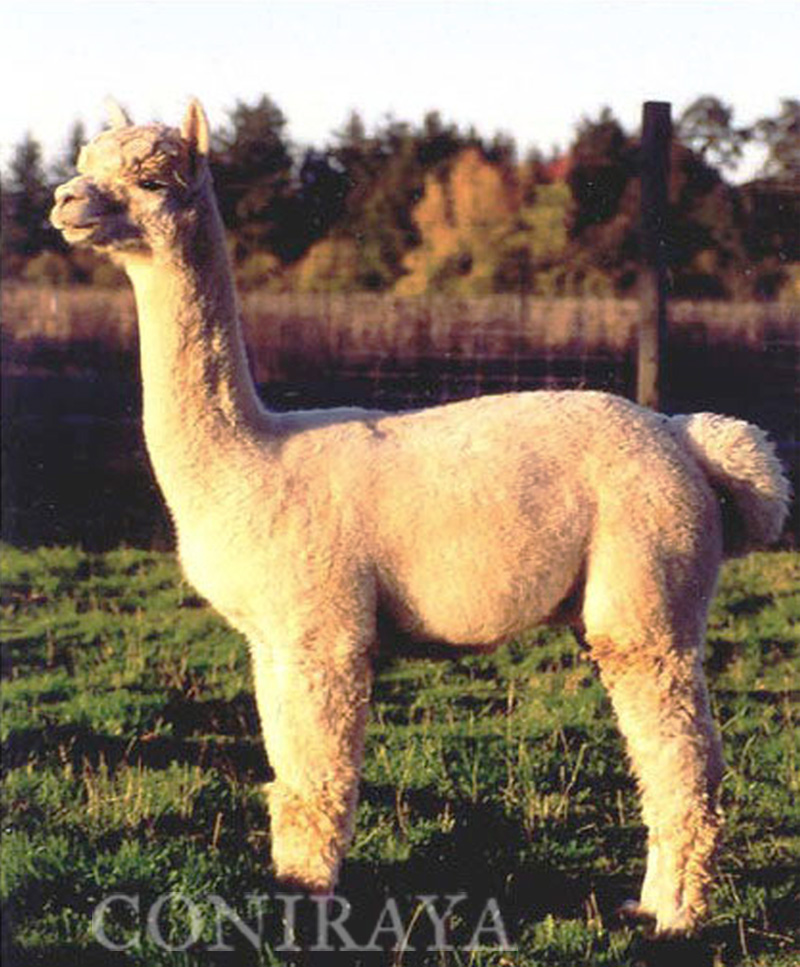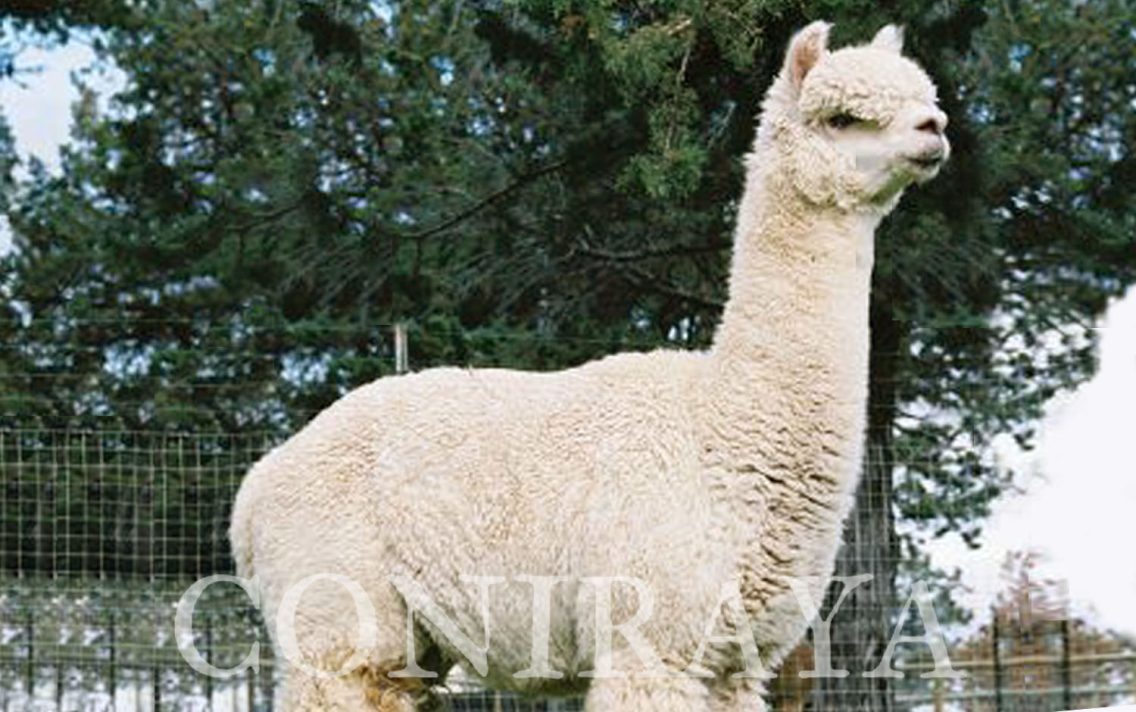A visit to Peru is the most moving. When we walk on the land from which our animals originate and meet alpaca breeders living high on the Altiplano, it is hard to contain our emotions.
My stay in the USA, where I had the opportunity to meet legendary breeders, visit their farms, and see animals that I had only read about so far, made me decide to systematize my knowledge related to the beginnings of alpaca breeding in the United States of America.
The beginnings of alpaca breeding in the USA date back to the 1980s, when Richard Patterson, owner of the excellent Arabian horse breeding farm Paterson Arabians (Oregon), often visited Poland in Michałów and Janów Podlaski.
He used to return to the USA via Great Britain and visit zoos and private zoos there, and on one occasion he came across alpacas.
It was Mr. Paterson who brought the first privately owned alpacas to the United States in 1980. Up until that time, alpacas could only be found in ZOOs.
The first significant shipment (several hundred animals) arrived in the United States from Bolivia and Chile in 1984.
However, it was not until 1993, after much effort, that an agreement was concluded with the Peruvian government and the first high-quality Peruvian alpacas were legally imported to North America.
Alpacas from Peru were exported to the USA between 1993 and 1998.
At the same time, alpacas were also exported from Peru to Canada, Australia and Europe.
Every animal breeding farm has its legendary representatives, and in the case of alpaca breeding it is the group of Peruvian males.
The first import of alpacas took place in 1993, all animals imported in this transport came from The Hacienda Cconchatanca, known to us as Rural Allianza.
The Allianza cooperative was the largest Peruvian alpaca breeder, with a total of around 40,000 animals and supplying large quantities of the highest quality fibre to the Peruvian market.
In 1993, several top quality alpacas were exported from Peru to “raise the bar” and increase future demand for the best animals.
In the first batch two males stood out. Peruvian Hemingway G171 and Peruvian Bueno G173.
They have made their presence felt in the North American alpaca population and deserve to be remembered.
Peruvian Hemingway G171, named after Ernest Hemingway, ranks third in the number of offspring registered (410), and was owned by Northwest Alpacas, Pacific Crest Alpacas, Morning Sun Alpacas and Timberland Alpacas, all from Oregon.
Mike Safley considered Hemingway and Caligula to be the two most important males for alpaca breeding in the United States.
Hemingway was presumably born in 1991 and his last recorded offspring was born on August 9, 2009, when the male was 17 years old.
In 1996, at the Estes Park, Colorado, show and the AOBA National Show in Denver, Colorado, Hemingway’s offspring won first place in the white juvenile male and female classes out of 25 competitors.
Hemingway’s fleece at age five averaged 17.8 micrometers, standard deviation 3.7, coefficient of variation 20%, 1% hairs over 30 μm. At age 16 his fleece averaged 23.7 μm!
What is particularly noteworthy about Hemingway’s offspring is the “cohesiveness” of their fleece, i.e. the low values of standard deviation and coefficient of variation – more than usual fibres in their fleece have a diameter close to the average, and this trait is usually inherited.

Peruvian Hemingway photo by Mike Safley
Peruvian Bueno G173, who retired as America’s eighth most prolific sire with 267 recorded offspring, lived most of his life at Maple Brook Alpacas in Massachusetts.
Bueno was also presumably born in 1991 and his last recorded offspring was born on June 30, 2011, when the male was 19 years old. Bueno achieved the highest price at the 1994 Spring Celebrity Sale.
The second import from Peru in 1994 began with the import of alpacas from Estancia Accoyo.
This farm is located near Macusani at an altitude of 4500 m above sea level.
Don Julio Barreda (1919-2006), founder and owner of Accoyo, who was then 75 years old and had been a breeder for over 50 years, personally selected the males included in the herd imported in 1994.
After a few years, Barreda answered the question whether he had decided to send the best of his males to the United States – he replied: “It was my calling card and I didn’t want Accoyo to be forgotten.”

Don Julio Barreda a painting by a Peruvian artist.
There were several males that stood out in this shipment, all from Accoyo.
Peruvian Caligula G4572 who had only 205 registered offspring – presumably born in 1988, was already six years old when imported to the US.
Don Julio considered him one of the three best males taken from Accoyo.
Caligula’s descendants won 12 get of sire competitions, including two at national shows of the AOBA breeders’ association.
His male and female offspring have won 17 championships at major shows in the United States, not counting awards for top animal breeders. Today, Caligula’s descendants live in Australia, Canada, New Zealand, and England, among other places.
PPeruvian Felix G4562 ranks fourth with 344 descendants registered in the database.
Felix is listed as either a light or dark fawn male, depending on the source. In any case, he was the darkest of the males imported from Accoyo in 1994, and many attempts were made to produce dark offspring from him. In 2000, the efforts paid off when he sired an all-black female that sold for $100,000 at the 2006 AOBA auction. In addition to passing on color, Felix was noted for improving the density of his fleece and the good conformation and attitude of his offspring. Felix was probably born in 1992 and sired his last registered offspring on December 3, 2007.
PPeruvian Vengador G4568 was probably born in 1991 and lived until May 14, 2009. His last offspring was born on June 12, 2009, when Vengador was 18 years old. Don Julio Barreda’s favorite male at Accoyo was Shere Khan, whose portrait was updated many times at the request of his owner, and Vengador from Accoyo was probably intended to be a descendant of Shere Khan.
Accoyo Victor had 238 registered offspring and was the twelfth most fertile male, while Peruvian Timoteo G4565 had only 78 registered offspring. Timoteo died tragically at the age of 9 from injuries sustained during a tornado attack on the farm – if not for that natural disaster, he would probably have had many more registered offspring.
From the memoirs of Don Julio Barreda it appears that he valued Timoteo very highly and listed him among the three best sires sent from Accoyo.
Don Julio began a strict selection of alpacas in 1946 and the results of his efforts were demonstrated during the shearing before quarantine and sale for export in 1995. Of the 462 huacaya alpacas, 92 came from Accoyo. The fleece from Accoyo weighed an average of 3.9 kg, the fleece from the other six farms 2.9 kg, a difference of 1 kg or 36%.
The Huacaya alpaca fleece from Accoyo had an average hair diameter of 22.13 μm, in some cases as small as 17 μm. The average standard deviation was 4.82 μm, and the coefficient of variation was 22.91%. The other imported animals had similar hair fineness, with a higher standard deviation, but the alpacas from Accoyo were on average 18 months older than the others.
The third export from Peru was in 1995 and again Accoyo males stood out the most.
The registered name of PPPeruvian Augusto 6009 was originally “Kansas, son of Killahuasi.”
In a 1995 letter, Don Julio Barreda wrote: “I am sure that the purchaser of Kansas will have reason to be pleased.”
When Peruvian Augusto 6009 was imported to the USA, it received a score of 9 out of 10 points, with two pluses each for uniformity, fleece density and head shape.
In 2000 he was sold at Breeder’s Choice Auction for $226,000 USD.
PPPeruvian Royal Fawn 6014 with 456 registered offspring ranks high on the list of the most prolific sires of all time.
Royal Fawn was purchased from Camelids of Delaware for a then-record price of $600,000 USD.
In the case of the fourth import from Peru in 1996, the males that stood out according to experts were 4Peruvian Pachacuti 6011 and 4Peruvian Legacy 6016.
Mike Safley, an outstanding judge and breeder, founder of the Quechua Benefit Foundation, contributed significantly to the inclusion of these alpacas bred by Don Julio Barreda in Accoyo in the group exported to the USA.
In 2005, Virginia Alpaca Farm and Breeding Co. acquired a half interest in 4Peruvian Legacy 6016 for a whopping $750,000, raising Legacy’s market value to $1.5 million and making him the most expensive sire in North America.
Legacy was named Futurity Herdsire of the Year in 2002 and Reserve Light Herdsire of the Year in 2005 and 2007. With 419 registered offspring, he ranks second in the ARI database, just behind Royal Fawn (456).

Accoyo Peruvian Legacy photo Crescent Moon Ranch
The male 5Petuvian Chaccu was probably born in 1992, therefore the hair test results obtained at the age of five and visible in the histogram are impressive: 19 μm, standard deviation 4.2, coefficient of variation 22, 1.7% >30, it should also be added that it was light fawn in color.
Chaccu lived until January 2011 and had 109 registered offspring – the last of his offspring was born on May 30, 2011.
With the last 6 export from Peru in 1998 came to the USA 6Peruvian Accoyo Elite 5057.
He was probably born in June 1996 and his last offspring was born on September 18, 2013.
In 2013 Elite was ranked in the top 1% of sires in SIX categories (average hair diameter AFD, standard deviation of average hair diameter SDAFD, spin fineness SF, percentage of hairs > 30 μm, standard deviation of curvature and percentage of medullary fibers).
On August 13, 2012, at the Snowmass Alpacas farm in Idaho, the male Snowmass Loro Piana, grandson of 6Peruvian Accoyo Elite 5057, was born.
Loro’s pedigree combines the traits of males such as Hemingway, Don Julio, Drambuie, Caligula, Legacy and Accoyo Elite.
A week before the ninth month, a histogram of Snowmass Loro Piana was produced, which showed the smallest known average hair diameter of 10.8 μm and a standard deviation of 2.8.
Lynn Edens said “Loro Piana is the first in our long-term breeding program to have a fiber finer than the Vicuña. Our goal of breeding animals with strong crimps, very fine hair, shine and high fleece growth has been achieved in this extraordinary male.
He is our highest achievement in breeding Ultra Royal Alpaca.”



